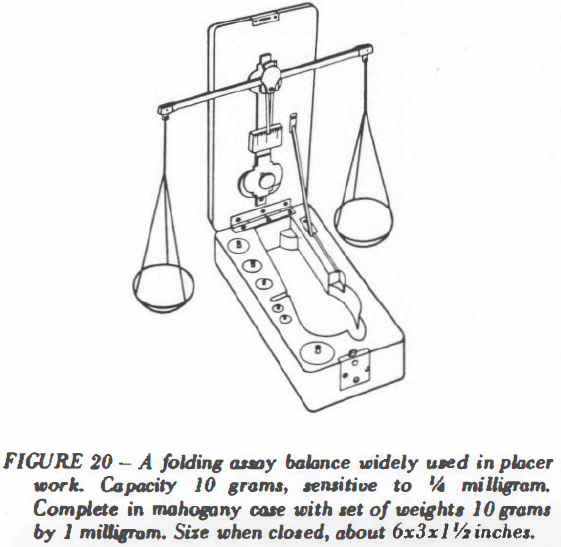Fire assaying, in essence, is a miniature or small scale smelting process which recovers and reports the total gold content of the assay sample, including gold combined with other elements or locked in the ore particles. Because of this, a assay may report values that cannot be recovered by placer methods and it cannot be too strongly stressed that when dealing with gold placers, the sample values should not be determined by fire assay. Furthermore, no credence should be placed in placer valuations or reports that are based on the results of fire assays. Although this should be common knowledge among mineral examiners, a surprising number seem unaware that fire assaying although accurate per se yields misleading results when applied to placers.
There are other reasons: First, consider the small quantity of material used in a fire assay. The usual amount of sample taken for a crucible charge is either 29.166 grams (one assay-ton) or half of this amount. Next, consider that a particle of placer gold only 1/32-inch in diameter may weigh about ¼ milligram. Now if the bank-run material from which it came averaged 10c per cubic yard, the ¼-milligram gold particle would be contained in about 7½ pounds of sand and gravel. But suppose this same ¼-milligram gold particle found its way into a 29-gram fire assay charge. The resulting assay-value would be ¼ ounce per ton. It is seen that a single small particle of gold, by placer standards, will cause an intolerable error when injected into a standard fire assay charge.
Experience tells us that with few exceptions no amount of mixing or careful division can produce a fire assay charge representative of bank-run placer material. The practice of first panning a sample to reduce its bulk, and then fire assaying the resultant black sand concentrate does not entirely resolve this problem.
Even if we assume that a representative crucible charge could be obtained, the fire assay will detect all gold including that which is locked up in rock particles or is too finely divided to be recovered by placer methods. This in itself precludes the use of fire assays for evaluating placer ground.
In brief, experience has shown that fire assay results applied to placers usually results in a substantial overvaluation of the ground.
HOW TO DETERMINING RECOVERABLE GOLD SAMPLES
- Reduce the original sample to a black sand concentrate by panning, rocking, or other suitable means.
- Place the concentrate in a pan, then count and record the gold colors as #3, #2 or #1 — size (Note 1). At this point, manually remove any gold particles which are to be kept in their natural form (Note 2).
- Add a globule of clean, gold- free mercury (about the size of a small bean) and working over a safety pan reduce the black sand to a small-volume concentrate. Near the end of panning process the mercury may tend to ride over the lop of fine-size or hard-packing materials but by this time all gold should have been picked up by the mercury.
- Remove the mercury and place it in a 250 ml Pyrex beaker. Add 40 or 50 ml diluted nitric acid (Note 3) and digest until the mercury globule is reduced to the size of a match head. Transfer to a #0 glazed porcelain parting cup, add fresh acid and complete the digestion using low heat if necessary. Fine-size gold will be left as a coherent, sponge-like mass if rapid digestion or boiling is avoided.
- After decanting off the acid, carefully wash the gold three or more times with warm water. Add a drop or two of alcohol (to prevent spattering) and dry in the parting cup at low heat.
- Anneal the gold by bringing the bottom of the parting cup to a low red heat. This step will eliminate any residual mercury and be essential when working with very small gold weights.
- Transfer the annealed gold to a balance pan and weigh. A balance widely used by placer engineers be shown in Figure 20.

NOTES on “home Fire Assaying”:
- Number 3 colors consist of gold particles weighing less than 1 milligram. Number 2 colors weigh between 1 milligram and 4 milligrams. Number 1 colors weigh over 4 milligrams. Gold particles weighing 10 milligrams or more should be individually weighed and recorded.
- Placer gold loses its original surface texture when amalgamated. In the case of fine-size gold, its end form may assume the shape of fine needle-like crystals which are actually pseudomorphs after gold amalgam.
- Prepare a parting solution by diluting commercial nitric acid with water to a strength which will dissolve mercury without violent action. A 1:1 dilution is usually satisfactory.
- Large-volume or hard-packing black sands that are difficult or tedious to pan may be amalgamated in a glass jar rotated about its longitudinal axis at a peripheral speed of 500 inches per minute. The addition of a small amount of lye will counteract oil or grease and will generally assist amalgamation.
- The described procedure will extract all free gold recoverable by commercial placer methods. With care, extremely low gold values can be determined. Where so-called “rusty” or coated gold is present, provisions should be made to scour or otherwise brighten the gold prior to amalgamation. This may be done by rubbing it on the bottom of the pan or adding a few pebbles to the amalgamating jar. Fine grinding or pulverizing should be avoided.
